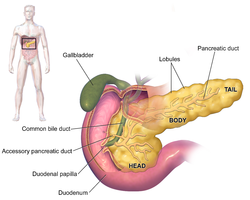
Back Pankreas Afrikaans Pancrias AN بنكرياس Arabic بنكرياس ARZ অগ্ন্যাশয় Assamese Páncrees AST Mədəaltı vəzi Azerbaijani Lapay BCL Падстраўнікавая залоза Byelorussian Падстраўнікавая залоза BE-X-OLD
| Pancreas | |
|---|---|
 Anatomy of the human pancreas | |
| Details | |
| Pronunciation | /ˈpæŋkriəs/ |
| Precursor | Pancreatic buds |
| System | Digestive system and endocrine system |
| Artery | Inferior pancreaticoduodenal artery, anterior superior pancreaticoduodenal artery, posterior superior pancreaticoduodenal artery, splenic artery |
| Vein | Pancreaticoduodenal veins, pancreatic veins |
| Nerve | Pancreatic plexus, celiac ganglia, vagus nerve[1] |
| Lymph | Splenic lymph nodes, celiac lymph nodes and superior mesenteric lymph nodes |
| Identifiers | |
| Latin | pancreas |
| Greek | πάγκρεας (pánkreas) |
| MeSH | D010179 |
| TA98 | A05.9.01.001 |
| TA2 | 3114 |
| FMA | 7198 |
| Anatomical terminology | |
The pancreas is an organ of the digestive system and endocrine system of vertebrates. In humans, it is located in the abdomen behind the stomach and functions as a gland. The pancreas is a mixed or heterocrine gland, i.e., it has both an endocrine and a digestive exocrine function.[2] 99% of the pancreas is exocrine and 1% is endocrine.[3][4][5][6] As an endocrine gland, it functions mostly to regulate blood sugar levels, secreting the hormones insulin, glucagon, somatostatin and pancreatic polypeptide. As a part of the digestive system, it functions as an exocrine gland secreting pancreatic juice into the duodenum through the pancreatic duct. This juice contains bicarbonate, which neutralizes acid entering the duodenum from the stomach; and digestive enzymes, which break down carbohydrates, proteins and fats in food entering the duodenum from the stomach.
Inflammation of the pancreas is known as pancreatitis, with common causes including chronic alcohol use and gallstones. Because of its role in the regulation of blood sugar, the pancreas is also a key organ in diabetes mellitus. Pancreatic cancer can arise following chronic pancreatitis or due to other reasons, and carries a very poor prognosis, as it is often only identified after it has spread to other areas of the body.
The word pancreas comes from the Greek πᾶν (pân, "all") & κρέας (kréas, "flesh"). The function of the pancreas in diabetes has been known since at least 1889, with its role in insulin production identified in 1921.
- ^ Nosek, Thomas M. "Section 6/6ch2/s6ch2_30". Essentials of Human Physiology. Archived from the original on 2016-03-24.
- ^ Gyr, K.; Beglinger, C.; Stalder, G. A. (1985-09-21). "[Interaction of the endo- and exocrine pancreas]". Schweizerische Medizinische Wochenschrift. 115 (38): 1299–1306. ISSN 0036-7672. PMID 2865807.
- ^ "Pancreas Gland - Endocrine System". Innerbody. Retrieved 2021-06-12.
- ^ Beger's 2018, pp. 124.
- ^ Alonso-Magdalena, Paloma; Tudurí, Eva; Marroquí, Laura; Quesada, Ivan; Sargis, Robert M.; Nadal, Angel (2019). "Toxic Effects of Common Environmental Pollutants in Pancreatic β-Cells and the Onset of Diabetes Mellitus". Encyclopedia of Endocrine Diseases. pp. 764–775. doi:10.1016/B978-0-12-801238-3.64325-8. ISBN 978-0-12-812200-6.
- ^ Henderson, J R; Daniel, P M; Fraser, P A (February 1981). "The pancreas as a single organ: the influence of the endocrine upon the exocrine part of the gland". Gut. 22 (2): 158–167. doi:10.1136/gut.22.2.158. PMC 1419227. PMID 6111521.